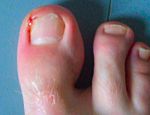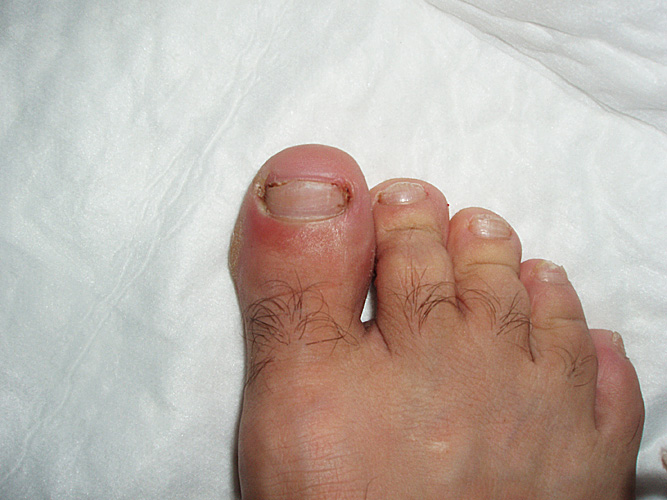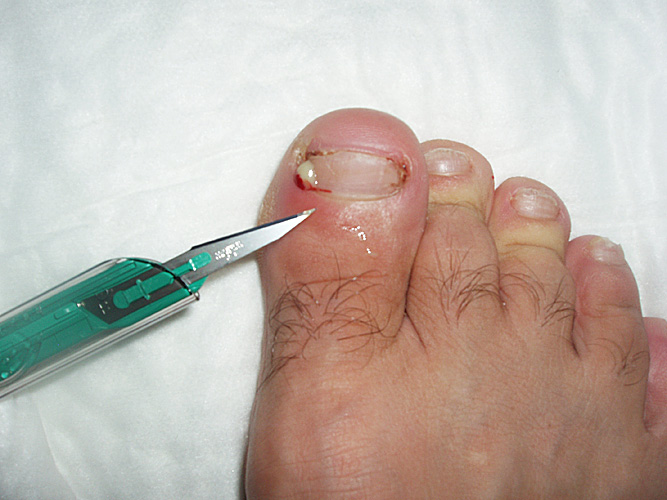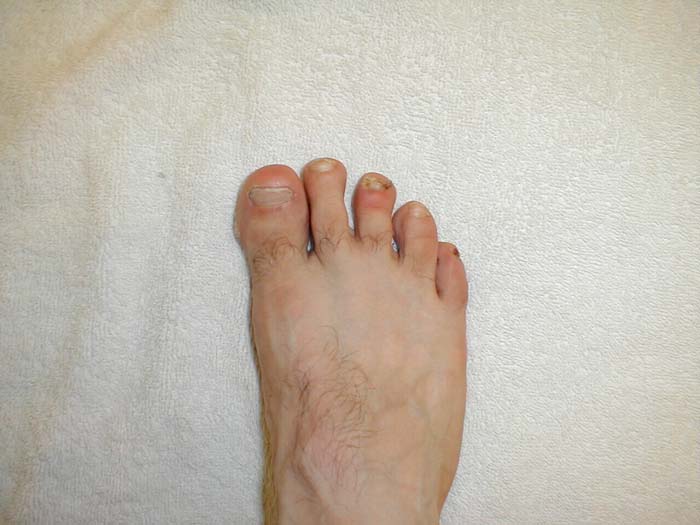Paronychia
| Paronychia | |
 | |
|---|---|
| Paronychia | |
| ICD-10 | L03.0 |
| ICD-9 | xxx |
| DiseasesDB | 9663 |
| MedlinePlus | 001444 |
| eMedicine | derm/798 |
Template:Search infobox Editor-In-Chief: C. Michael Gibson, M.S., M.D. [1]
Synonyms and keywords: Felon, Whitlow
Please Join in Editing This Page and Apply to be an Editor-In-Chief for this topic: There can be one or more than one Editor-In-Chief. You may also apply to be an Associate Editor-In-Chief of one of the subtopics below. Please mail us [2] to indicate your interest in serving either as an Editor-In-Chief of the entire topic or as an Associate Editor-In-Chief for a subtopic. Please be sure to attach your CV and or biographical sketch.
Overview
The nail disease paronychia is an often tender bacterial or fungal infection where the nail and skin meet at the side or the base of a finger or toenail. It can start suddenly (acute paronychia) or gradually (chronic paronychia). Despite the small area affected these infections can be extremely painful as the skin becomes inflamed, hot, red, and throbs continually. Pus is usually present, along with gradual thickening and browning discoloration of the nail plate.
Classification
Acute paronychia is usually caused by bacteria. This is often treated with antibiotics, sometimes as a cream, other times orally.
Chronic paronychia is most often caused by a yeast infection of the soft tissues around the nail but can also be traced to a bacterial infection. If the infection goes on and on then a fungal infection is often the cause and this needs anti-fungal cream or paint to treat it.
Pathophysiology
The cuticle acts as a protective seal, but if it is damaged in any way then pathogens are able to enter the skin and cause infection.
If a large amount of pus has collected, then it may be necessary to make a small cut in the skin (sometimes under local anaesthetic) to release it.[1]
If someone has a cold sore and puts their finger in their mouth then a herpes infection whitlow may appear. Herpes whitlows are frequently found among dentists and dental hygienists.[2] Prosector's paronychia is a primary inoculation of tuberculosis of the skin and nails, named after its association with prosectors, who prepare specimens for dissection. Paronychia around the entire nail is sometimes referred to as runaround paronychia.
Painful paronychia in association with a scaly, erythematous, keratotic rash (papules and plaques) of the ears, nose, fingers, and toes, may be indicative of acrokeratosis paraneoplastica, which is associated with squamous cell carcinoma of the larynx.[3]
-
Paronychia of the big toe
-
Paronychia: Infection of the skin medial and inferior to nail of great toe.
(Courtesy of Charlie Goldberg, M.D.) -
Paronychia: Infection of the skin medial and inferior to nail of great toe. Post I&D.
(Courtesy of Charlie Goldberg, M.D.) -
Paronychia: Infection of the skin medial to nail of middle toe.
(Courtesy of Charlie Goldberg, M.D.)
Causes
Causes in Alphabetical Order
- Bacteria
- Candida albicans
- Herpes simplex
- Herpes simplex virus 2
- Panitumumab
- Pseudomonas aeruginosa
- Staphylococcus aureus
- Syphilis
Treatment
Paronychia Treatment[4]
Self-Care at Home:
Care at home includes warm soaks in a mixture of 50% warm water and 50% liquid antibacterial soap 3-4 times daily for about 15 minutes. This soaking should be done at the first sign of redness around the nail.
Medical Treatment:
If an abscess (pus pocket) has formed, the recommended treatment is to drain the abscess by doing an incision and drainage procedure.
The doctor will most likely use medicine (such as lidocaine) to numb the entire finger first and then will open the abscess using a surgical knife (scalpel).
Sometimes packing called a wick is placed in the abscess to allow it to continue to drain when you go home and to keep it from closing up and re-forming the abscess. The packing is usually left in for 24-48 hours.
In extreme cases, infection can move under the fingernail and need partial or complete nail removal. Unless there is an extensive cellulitis (inflammation and infection of the soft tissue around the nail), antibiotics are usually not necessary.
Your doctor may or may not take a culture of the drainage to check for a bacterial infection.
After your doctor has drained the paronychia, warm soaks are still recommended. Usually, antibiotics are only prescribed if the infection involves more of the finger than around the nailbed. It is important to follow up with your doctor in 24-48 hours to be sure that the infection is healing properly
References
- ↑ Jacobs, J.R. (2006 June-July). "Pathophysiology and Management of Paronychia". collegehealth-e. Text " pp. 10–12" ignored (help); Unknown parameter
|Issue=ignored (|issue=suggested) (help); Check date values in:|date=(help) - ↑ Lewis, M.A. (April 2004). "Herpes simplex virus: an occupational hazard in dentistry". International Dental Journal (2): 103–111. doi:10.2956/indj.2004.54.2.103. Unknown parameter
|vol=ignored (|volume=suggested) (help) - ↑ Karen Allen, MD. "eMedicine - Acrokeratosis Neoplastica". Text " 2005-08-17 " ignored (help)
- ↑ Directly from WebMD
External links
- "Paronychia Nail Infection". Dermatologic Disease Database. American Osteopathic College of Dermatology. Text " 20" ignored (help)



